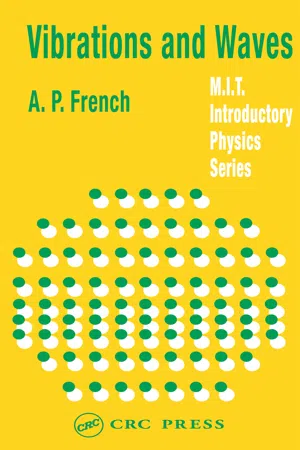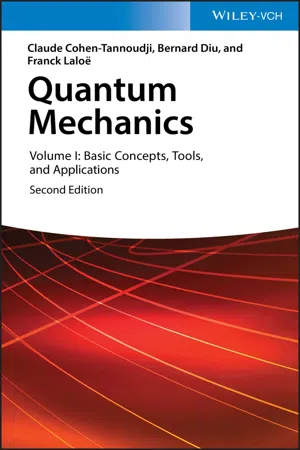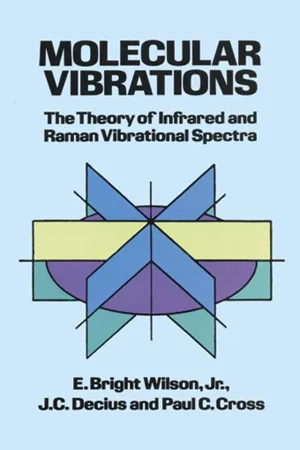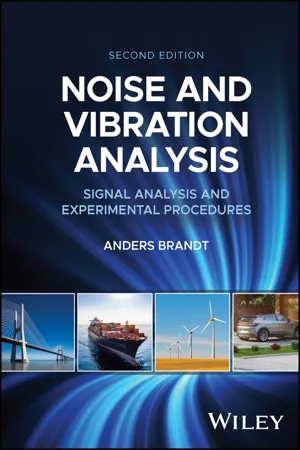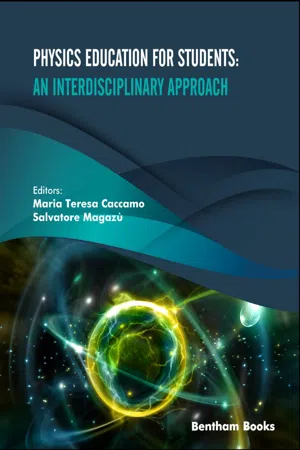Physics
Normal Modes
Normal modes refer to the specific patterns of motion exhibited by a system when it is disturbed from its equilibrium position. In physics, these modes are characterized by the frequencies at which the system naturally oscillates. Understanding normal modes is crucial for analyzing the behavior of complex systems, such as vibrating strings or molecules, and for predicting their responses to external forces.
Written by Perlego with AI-assistance
Related key terms
Related key terms
1 of 4
Related key terms
1 of 3
6 Key excerpts on "Normal Modes"
- eBook - ePub
- Jeanne L. McHale(Author)
- 2017(Publication Date)
- CRC Press(Publisher)
The ellipsoids centered at each atom represent the average root-mean-square deviation of the atom from its equilibrium position. The sizes of these ellipsoids increase with temperature as the amplitude of vibrational motion increases. If you visualize each atom jiggling about within the volume of each little ORTEP ellipsoid, the concept of Normal Modes is hardly apparent. The Normal Modes are a set of 3 N − 6 collective atomic displacements which may be superimposed to describe the overall vibrational motion of the molecule. † They represent a way of resolving the total vibrational motion (the ORTEP picture) into independent modes of motion. If the motion in one of these Normal Modes is mostly concentrated in a particular bond or part of the molecule, then the idea of a characteristic group frequency is valid. More generally, a normal mode is a combination of motions involving all the atoms to varying degrees. The set of atomic displacements that characterizes the normal mode is a normal coordinate, which we call Q i for the i -th normal mode. This decomposition of the overall motion into 3 N − 6 Normal Modes is made possible by the harmonic oscillator approximation, which allows the total potential energy for a given electronic state to be expressed as a sum of 3 N − 6 quadratic functions of the normal coordinates. A harmonic potential written in terms of a set of coordinates other than the normal coordinates would contain mixed quadratic terms. The normal coordinates allow separation of variables to be employed, greatly simplifying both the classical and quantum mechanical treatments. The assumption is made that the forces between atoms are harmonic; that is, they obey Hooke’s law. Hooke’s law states that the restoring force of the spring is proportional to its displacement from equilibrium, the proportionality constant being the force constant k. The stronger the bond is, the stiffer the “spring” and the larger the force constant - eBook - ePub
- A.P. French(Author)
- 2017(Publication Date)
- CRC Press(Publisher)
2 Nevertheless, the important feature remains—that a given one-dimensional system, with specified boundary conditions, has a denumerable set (even if infinite) of characteristic natural modes of vibration.Let us end this general discussion of the Normal Modes by drawing attention to two features, already referred to, that are of especially great importance:1 For further discussion, refer back to Chapter 5 .2 Even in a one-dimensional system that is treated as being continuous in structure, the relation between the mode frequencies becomes quite different if the system is not uniform—e.g., a stretched string whose thickness increases continuously from one end to the other, or (as shown in Fig. 5-1 ) a uniform chain hanging vertically, in which the tension decreases steadily from the top downward.- The boundary conditions , as applied in this case at the two ends of the one-dimensional system, play a decisive role in determining the character of the Normal Modes.
- Given the linearity of our basic equations of motion, any or all of the Normal Modes of vibration can coexist with arbitrary relative values of amplitude and phase.
Normal Modes of a Two-Dimensional System
We shall turn our attention now to a brief consideration of the Normal Modes of systems that are essentially two-dimensional, such as a stretched elastic sheet or a thin metal plate. As with the one-dimensional systems, the specification of boundary conditions —now, primarily, around the edges—limits the permissible motions to a few particular classes: the Normal Modes that are consistent with the stated boundary conditions. The precise character of the Normal Modes may be very beautifully indicative of any symmetries that a given physical system possesses. - eBook - ePub
Quantum Mechanics, Volume 1
Basic Concepts, Tools, and Applications
- Claude Cohen-Tannoudji, Bernard Diu, Franck Laloë(Authors)
- 2020(Publication Date)
- Wiley-VCH(Publisher)
k. The process of finding the eigenstates and eigenvalues of the quantum mechanical Hamiltonian is then greatly simplified by the fact that the total energy of the system is the sum of the energies associated with each vibrational normal mode.The results obtained will enable us to indicate how vibrations propagate in a crystal and to introduce the concept of a phonon, a central idea in solid state physics. Of course, in this complement, we shall emphasize the introduction and quantization of the Normal Modes, and not the detailed properties of phonons, which would be treated in a solid state physics course.1. Classical treatment
1-a. Equations of motion
Let us consider an infinite chain of identical one-dimensional harmonic oscillators, each one labeled by an integer q (positive, negative or zero). The particle Mq of mass m which constitutes oscillator (q) has its equilibrium position at the point whose abscissa is ql (Fig. 1 ), where l is the unit distance of the oscillator chain. We denote by xq the (algebraic) displacement of oscillator (q) with respect to its equilibrium position. The state of the system at the instant t is defined by specifying the dynamical variables xq (t) and their time derivatives at this instant.In the absence of interactions between the various particles, the potential energy of the system is:Figure 1 : Infinite chain of oscillators; the displacement of the th particle with respect to its equilibrium position ql is denoted by xq .(1)where ω is the angular frequency of each oscillator. The evolution of the system is then given by the equations:(2)whose solutions are:(3)where the integration constants and φq are fixed by the initial conditions of the motion. The oscillators therefore vibrate independently.Now imagine that these particles are interacting. For simplicity, we shall assume that one need take into account only the forces exerted on a particle by its two nearest neighbors and that these forces are attractive and proportional to the distance. Thus, particle (q) is subjected to two new attractive forces exerted by particles (q + 1) and (q − 1). These forces are proportional to |Mq Mq +i| and |Mq Mq -i| (the coefficient of proportionality being the same in both cases). The total force Fq to which particle (q - eBook - ePub
Molecular Vibrations
The Theory of Infrared and Raman Vibrational Spectra
- E. Bright Wilson, J. C. Decius, Paul C. Cross(Authors)
- 2012(Publication Date)
- Dover Publications(Publisher)
In writing the range of k as 1 to 3 N, it is implied that there are 3 N sets l ik, whereas there are only 3 N − 6 Normal Modes of vibration. The other six sets l ik are obtained when the value 0 is substituted for λ k in Eq. (10), Sec. 2-2. Since this root of the secular equation occurs six times, there will be six independent sets of l ik ’s, or six independent modes of motion with zero frequency. It will be shown that these correspond to the three translations and three rotations of the molecule. Equation (1) is the mathematical way of expressing the result obtained when the Normal Modes of motion are superimposed with arbitrary amplitudes K k and arbitrary phases ε k. The values of the K ’s and ε ’s depend on the initial conditions; i.e., the way in which the motion was imparted to the molecule. Since there is the proper number of independent arbitrary constants, (1) is the most general solution of the problem. 2-4. Normal Coordinates Definition. In order to carry out the quantum mechanical treatment of molecular vibrations, it is necessary to introduce a new set of coordinates Q k, k = 1, 2,. . . , 3 N, called normal coordinates. It will be shown that there is one normal coordinate associated with each normal mode of motion, and vice versa. The normal coordinates are defined in terms of the mass-weighted cartesian displacement coordinates q i by the linear equations in which the coefficients have been chosen so that in terms of the new coordinates the kinetic and potential energies have the forms In other words, the potential energy in terms of the normal coordinates involves no cross products but only squares of Q ’s, while the kinetic energy retains its original form. It will now be shown how the are related to the l ik of Eq. (12), Sec. 2-2, and how the constants are related to the normal frequencies λ - eBook - ePub
Noise and Vibration Analysis
Signal Analysis and Experimental Procedures
- Anders Brandt(Author)
- 2023(Publication Date)
- Wiley(Publisher)
, where they are reflected (change sign, so if the wave shape was pointing upwards, for example it is pointing downward after the reflection) and move back and forth for all eternity. That is, if there is no damping.An alternative way to describe the deformation patterns moving back and forth is by using solutions to the wave equation: of the form(6.3)for example. In order to use these solutions, however, there must be a known closed‐form solution; we need to have the equation. The versatility of modes lies in the fact that the modes give exactly the same answers (the modes can be calculated from the wave equation), but the modes can be calculated or experimentally determined in many cases, for which we do not know the closed‐form solutions to the wave equations. Furthermore, even rather basic mechanical geometries, such as plates and beams, have several wave types which sum up to the total solution. In most cases, these are very difficult (read: impossible) to obtain on real‐life structures such as bridges, buildings, airplanes, and refrigerators. However, the modes can be obtained in several ways; most commonly from an finite element (FE - Maria Teresa Caccamo, Salvatore Magazù(Authors)
- 2021(Publication Date)
- Bentham Science Publishers(Publisher)
Normal Mode Investigation of a System of Coupled Oscillators: a Physics LectureMaria Teresa Caccamo,1 , *Salvatore Magazù11 Dipartimento di Scienze Matematiche e Informatiche, Scienze Fisiche e Scienze della Terra, Università di Messina, Viale Ferdinando Stagno D'Alcontres n°31, S. Agata,98166, Messina, ItalyAbstract
In this work the contents of an academic lecture addressed to first year Physics students on a system of coupled oscillators is presented. More specifically, the physical system dealt is constituted by two oscillating masses interacting through a connecting spring. At first, the theory describing the system dynamics is presented by putting into evidence how the diagonalization process allows to reduce the coupled oscillation equations to formally simpler, but physically equivalent, expressions which make reference to uncoupled oscillations and how the new chosen coordinates do not refer to the positions of the real masses but describe collective properties of the system, namely its Normal Modes. To facilitate the comprehension of the analytical procedure, an experiment addressed to characterize the system normal mode frequencies is proposed. On this purpose, for analysing the oscillation amplitude as a function of time, a comparison between Fourier Transform and Wavelet Transform is presented. What it emerges is that, differently from what occurs for Fourier Transform which provides a value of the motion average frequency, the Wavelet Transform allows to simultaneously execute a time–frequency analysis.Keywords: Coupled oscillators, Fourier Transform, Wavelet Transform.* Corresponding author Maria Teresa Caccamo: Dipartimento di Scienze Matematiche e Informatiche, Scienze Fisiche e Scienze della Terra, Università di Messina, Viale Ferdinando Stagno D'Alcontres n°31, S. Agata,98166, Messina, Italy; Tel: +39 0906765019; E-mail: [email protected]
Index pages curate the most relevant extracts from our library of academic textbooks. They’ve been created using an in-house natural language model (NLM), each adding context and meaning to key research topics.
Explore more topic indexes
Explore more topic indexes
1 of 6
Explore more topic indexes
1 of 4

